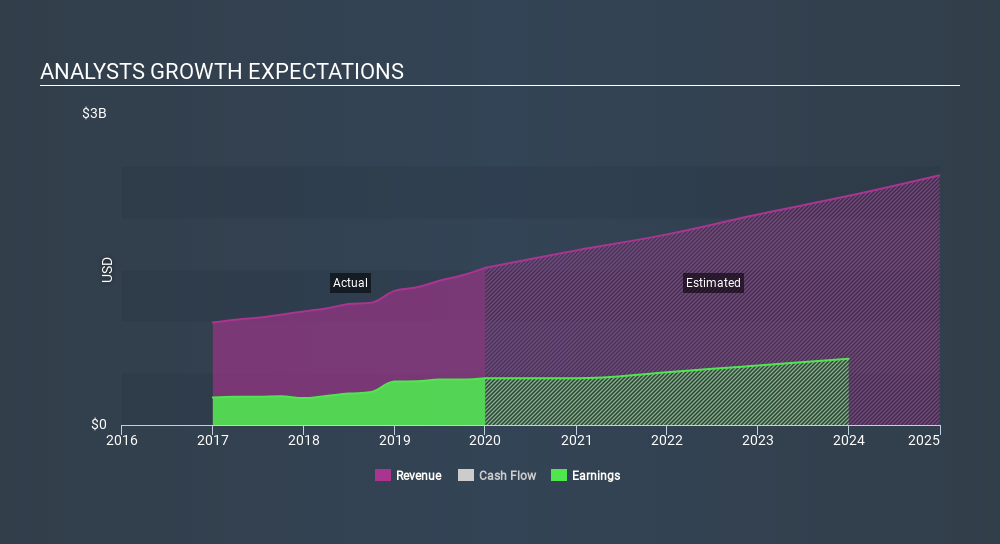- United States
- /
- Software
- /
- NasdaqGS:ANSS
Earnings Beat: ANSYS, Inc. Just Beat Analyst Forecasts, And Analysts Have Been Updating Their Models

It's been a sad week for ANSYS, Inc. (NASDAQ:ANSS), who've watched their investment drop 17% to US$244 in the week since the company reported its yearly result. ANSYS reported US$1.5b in revenue, roughly in line with analyst forecasts, although statutory earnings per share (EPS) of US$5.25 beat expectations, being 6.0% higher than what analysts expected. Following the result, analysts have updated their earnings model, and it would be good to know whether they think there's been a strong change in the company's prospects, or if it's business as usual. So we gathered the latest post-earnings forecasts to see what analysts' statutory forecasts suggest is in store for next year.
Check out our latest analysis for ANSYS

Following the latest results, ANSYS's eleven analysts are now forecasting revenues of US$1.68b in 2020. This would be a notable 11% improvement in sales compared to the last 12 months. Statutory earnings per share are expected to reduce 2.5% to US$5.22 in the same period. Yet prior to the latest earnings, analysts had been forecasting revenues of US$1.67b and earnings per share (EPS) of US$5.31 in 2020. So it's pretty clear that, although analysts have updated their estimates, there's been no major change in expectations for the business following the latest results.
It will come as no surprise then, to learn that the consensus price target is largely unchanged at US$256. Fixating on a single price target can be unwise though, since the consensus target is effectively the average of analyst price targets. As a result, some investors like to look at the range of estimates to see if there are any diverging opinions on the company's valuation. Currently, the most bullish analyst values ANSYS at US$323 per share, while the most bearish prices it at US$140. Note the wide gap in analyst price targets? This implies to us that there is a fairly broad range of possible scenarios for the underlying business.
Another way to assess these estimates is by comparing them to past performance, and seeing whether analysts are more or less bullish relative to other companies in the market. Next year brings more of the same, according to analysts, with revenue forecast to grow 11%, in line with its 10% annual growth over the past five years. Compare this with the wider market, which analyst estimates (in aggregate) suggest will see revenues grow 12% next year. So although ANSYS is expected to maintain its revenue growth rate, it's only growing at about the rate of the wider market.
The Bottom Line
The most important thing to take away is that there's been no major change in sentiment, with analysts reconfirming that earnings per share are expected to continue performing in line with their prior expectations. They also reconfirmed their revenue estimates, with the company predicted to grow at about the same rate as the wider market. The consensus price target held steady at US$256, with the latest estimates not enough to have an impact on analysts' estimated valuations.
With that said, the long-term trajectory of the company's earnings is a lot more important than next year. We have forecasts for ANSYS going out to 2024, and you can see them free on our platform here.
We also provide an overview of the ANSYS Board and CEO remuneration and length of tenure at the company, and whether insiders have been buying the stock, here.
If you spot an error that warrants correction, please contact the editor at editorial-team@simplywallst.com. This article by Simply Wall St is general in nature. It does not constitute a recommendation to buy or sell any stock, and does not take account of your objectives, or your financial situation. Simply Wall St has no position in the stocks mentioned.
We aim to bring you long-term focused research analysis driven by fundamental data. Note that our analysis may not factor in the latest price-sensitive company announcements or qualitative material. Thank you for reading.
About NasdaqGS:ANSS
ANSYS
Develops and markets engineering simulation software and services for engineers, designers, researchers, and students.
Flawless balance sheet with solid track record.
Similar Companies
Market Insights
Community Narratives





